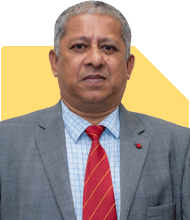Ramalingam Kalirajan |8327 Answers |Ask -Follow
Mutual Funds, Financial Planning Expert - Answered on Jul 12, 2024
He has an MBA in finance from the University of Madras and is a certified financial planner.
He is the director and chief financial planner at Holistic Investment, a Chennai-based firm that offers financial planning and wealth management advice.... more

Hello sir, i am 28 years male i have Doctor of Pharmacy a doctorate degree in India, but unfortunately couldn't find a stable job till date. I have multiple domain experiences worked in various companies and different fields moving away from my core. But could not manage to get more than 30k inhand. Now i plan to start a pharmaceutical wholesale/distributorship. I dont have any experience in particular to this....but my educational background and knowledge supports it. My research suggests i need atleast 15-20 lakhs to take the first step towards this goal. I have a corpus of just above 10 lakhs which is distributed in investments( sip 2000/m, stocks 2L, gold and silver 3L, personal loan i have given 3L, 50k liquid) so i dont want to withdraw any of these. Can you please suggest a better idea of how can i achieve this goal, so that i am financially stable in coming 5 years. Thankyou
Assessing Your Current Financial Situation
First, let’s analyze your current financial assets:
SIP (Systematic Investment Plan): Rs 2,000/month
Stocks: Rs 2 lakhs
Gold and Silver: Rs 3 lakhs
Personal Loan Given: Rs 3 lakhs
Liquid Cash: Rs 50,000
You have wisely diversified your investments, which is a strong foundation. However, you require Rs 15-20 lakhs to start your wholesale/distributorship business, and you prefer not to liquidate your existing investments. This calls for a strategic approach to bridge the financial gap without disrupting your current investments.
Leveraging Existing Investments
Gold and Silver Investments
Gold and silver are relatively stable assets. Instead of selling them outright, consider leveraging them. Many banks and financial institutions offer loans against gold. This way, you can utilize the value of your gold and silver without selling them, providing you with the necessary liquidity for your business venture.
Personal Loan Given
The Rs 3 lakhs you have lent out can be a resource. If possible, negotiate with the borrower for an early repayment. You could offer a slight discount on the interest rate as an incentive for early repayment. This can provide you with additional liquidity.
Stock Investments
Your Rs 2 lakhs in stocks can be partially leveraged. You might consider a margin loan against these stocks, which allows you to borrow money by using your existing shares as collateral. Be cautious with this option, as the stock market can be volatile.
Exploring Financing Options
Business Loans
Consider applying for a business loan from a bank or financial institution. Given your educational background and business plan, you might qualify for a start-up loan. Prepare a detailed business plan outlining your strategy, projected income, and how you plan to repay the loan. This increases your chances of securing the loan.
Government Schemes
Look into government schemes that support small and medium-sized enterprises (SMEs). Schemes like the Pradhan Mantri Mudra Yojana (PMMY) provide loans up to Rs 10 lakhs for non-corporate, non-farm small/micro enterprises. These loans can be an excellent way to secure additional funding without hefty interest rates.
Venture Capital and Angel Investors
If you’re open to it, consider seeking venture capital or angel investors. These investors provide capital in exchange for equity or a share of the profits. This can be a good way to secure significant funding without taking on debt, though it means sharing ownership of your business.
Building a Strong Financial Plan
Creating a Budget
Develop a detailed budget for your business. Outline all initial costs, ongoing expenses, and expected revenue. This helps in understanding how much funding you need and when you can expect to break even and start making a profit.
Emergency Fund
While focusing on your business, don’t forget personal financial stability. Maintain an emergency fund equivalent to six months of personal and business expenses. This ensures that unexpected expenses don’t derail your plans.
Systematic Withdrawal Plan (SWP)
Consider setting up a Systematic Withdrawal Plan from your mutual funds. This provides a regular inflow of funds while keeping your investment intact. It’s a way to create liquidity without liquidating your investments.
Enhancing Your Financial Knowledge
Educational Courses and Certifications
Though you have a solid educational background, consider taking courses related to business management and finance. Certifications in these areas can boost your confidence and competence in managing your new venture.
Mentorship
Seek out mentors who have experience in the pharmaceutical wholesale business. Their guidance can be invaluable, helping you avoid common pitfalls and providing insights that can lead to success.
Monitoring and Adjusting Your Strategy
Regular Financial Reviews
Set up a schedule for regular financial reviews. Assess your business’s financial health, review your investment portfolio, and adjust your strategy as needed. This ensures you stay on track towards your financial goals.
Staying Informed
Stay updated with market trends, both in the pharmaceutical industry and in finance. This knowledge helps you make informed decisions and adapt to changes in the market environment.
Final Insights
Your ambition and strategic thinking are commendable. With a clear plan and disciplined approach, you can bridge the financial gap and achieve your business goals. Utilize the value of your current investments wisely, explore various financing options, and continually enhance your financial knowledge. This comprehensive approach will help you build a successful pharmaceutical wholesale/distributorship and achieve financial stability in the next five years.
Best Regards,
K. Ramalingam, MBA, CFP
Chief Financial Planner
www.holisticinvestment.in
You may like to see similar questions and answers below
Ramalingam Kalirajan |8327 Answers |Ask -Follow
Mutual Funds, Financial Planning Expert - Answered on Jun 04, 2024
Ramalingam Kalirajan |8327 Answers |Ask -Follow
Mutual Funds, Financial Planning Expert - Answered on Jul 23, 2024
Milind Vadjikar |1210 Answers |Ask -Follow
Insurance, Stocks, MF, PF Expert - Answered on Jan 26, 2025
Dr Dipankar Dutta |1231 Answers |Ask -Follow
Tech Careers and Skill Development Expert - Answered on May 09, 2025
Archana Deshpande |105 Answers |Ask -Follow
Image Coach, Soft Skills Trainer - Answered on May 09, 2025
Shalini Singh |153 Answers |Ask -Follow
Dating Coach - Answered on May 09, 2025
Shalini Singh |153 Answers |Ask -Follow
Dating Coach - Answered on May 09, 2025
Dr Dipankar Dutta |1231 Answers |Ask -Follow
Tech Careers and Skill Development Expert - Answered on May 09, 2025
Dr Dipankar Dutta |1231 Answers |Ask -Follow
Tech Careers and Skill Development Expert - Answered on May 09, 2025
Dr Dipankar Dutta |1231 Answers |Ask -Follow
Tech Careers and Skill Development Expert - Answered on May 09, 2025
Prof Suvasish Mukhopadhyay |630 Answers |Ask -Follow
Career Counsellor - Answered on May 09, 2025
Samraat Jadhav |2274 Answers |Ask -Follow
Stock Market Expert - Answered on May 09, 2025
Ramalingam Kalirajan |8327 Answers |Ask -Follow
Mutual Funds, Financial Planning Expert - Answered on May 09, 2025









.jpg)














